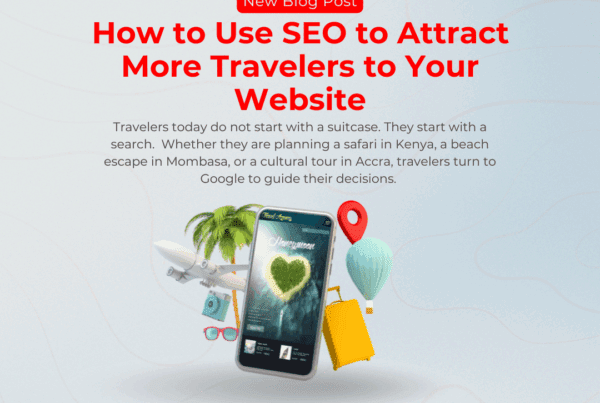It is no secret that, proper search engine optimization (SEO) for your nonprofit website brings more visitors. But can it translate to more donations? Absolutely! If you’re looking for new donor or supporters online, SEO is a powerful, yet often forgotten secret weapon.
By optimizing your website, you’ll become more visible in searches related to your cause, attracting potential donors who actively seek organizations like yours. It’s a win-win: they find you, you connect with them, and your impact grows!
How is SEO and Fundraising Connected?
Raising money online requires a strategic blend of key elements, each playing a crucial role in turning website visitors into passionate supporters. Let’s break it down:
A Trustworthy Website
Imagine your website as the welcoming face of your organization. It needs to be informative, engaging, and instill trust in potential donors. High-quality content, clear messaging, and a user-friendly design are crucial to building a positive first impression.
Don’t have a website yet or need a redesign? CHARLESON® offers web design and development services to nonprofits and NGOs in Kenya.
Attracting the Right Audience
Website traffic is great, but relevant, quality traffic is gold. Search engine optimization (SEO) and targeted online campaigns ensure your cause reaches the right people – those actively searching for organizations like yours.
A Smooth Donor Journey
Once visitors arrive, a seamless journey is key. Make it easy for them to understand your mission, connect with your stories, and discover how they can contribute. Clear donation options, a user-friendly donation process, and transparent impact reporting are essential to convert interest into action.
Direct Online Donations
Eliminate friction! Offer a convenient and secure way for supporters to donate directly on your website. By integrating online donation platforms or payment gateways, you streamline the process and remove barriers to giving.
For example; You can have donors contribute directly to your organization through Daraja API, a platform that allows money collection online via M-PESA. It is easy to set up and convenient for you website visitors to make a donation in less than 15 seconds.
Child Line Example (A Nonprofit Project by CHARLESON®)
See how Child Line Kenya created a pop-up on their landing page for the “Be a 1 Bob Hero” campaign making it easy for website visitors to make donations directly from their M-Pesa. The campaign aims to raise funds that go towards helping child abuse and neglect in Kenya where donors can contribute as little as 1 Kenya Shilling.

Remember all that effort you put into crafting a credible website with rich, accurate information? Guess what? It directly supports your online fundraising too! Why? Because those very same qualities fuel effective SEO as well:
- Credibility attracts trust: Just like donors seek reliable information, search engines value trustworthy websites. Your dedication to accuracy and transparency benefits both donors and search rankings.
- Engaged traffic equals potential supporters: Optimizing for relevant keywords ensures your website reaches an audience genuinely interested in your cause. These engaged visitors are prime candidates for becoming enthusiastic donors.
- Seamless navigation wins hearts: User-friendly websites are a must for both donors and search engines. Intuitive navigation, responsive design, and fast loading times keep visitors happy and exploring – and ultimately, donating.
SEO considerations on How to Attract Donors Online
Now that we understand how search engine optimization and fundraising are connected, let us delve into how we can use SEO basics to find donors online.
1. Target key word phrases based on your donor’s interests
Optimizing your website for search engines is crucial for attracting donors online, but using generic keywords like “donate now” is like screaming in a crowded city. To truly connect, you need to speak your donor’s language.
Imagine your ideal supporter. What are they searching for? Are they looking for a “hunger relief program in [city]” or just “ways to help“? Understanding their specific needs and concerns is key to selecting the right keywords.
Ditch the generic word phrases and keywords on your website and embrace specific longtail keywords:
- Target location: Optimize pages for keywords like “[city name] organizations for persons with disabilities” instead of just “organizations for persons with disabilities.”
- Highlight your impact: Use keywords related to the issues you address, like “help stop child abuse in [location]” instead of “stop child abuse.”
- Appeal to interests: Think beyond just “donate.” Use keywords like “contribute to [organization] [cause]” or “how to advocate for [cause].”
2. Optimize landing pages
Imagine someone Googles “animal welfare in Kenya” and lands on your page dedicated to elephant conservation. They might not know your organization yet, but your SEO work brought them there. Now, the real challenge begins: converting interest into action.
This is where landing pages become your secret weapon. These targeted pages focus on a single issue or campaign, optimized for your chosen keyword – in this case, “animal welfare in Kenya.” But remember, you’re not just competing with other organizations; you’re competing with a sea of information.
The key lies in crafting a captivating narrative:
- Start with an emotional hook: Use compelling images, statistics, or personal stories to grab attention and connect with visitors on an emotional level.
- Educate and inspire: Explain your mission, highlight your impact, and showcase the specific need related to the keyword. Use clear, concise language, avoiding jargon.
- Provide a clear call to action: Don’t leave visitors guessing. Offer multiple ways and channels for donating to your cause.
- Optimize for search engines: While storytelling is crucial, don’t forget technical SEO. Include your target keyword naturally in the title, headings, and throughout the text.
Remember, search engines value fresh, relevant content. Regularly update your landing pages with new stories, news, and progress updates. This not only engages visitors but also signals to search engines that your page is dynamic and authoritative.
By weaving together emotional storytelling and strategic SEO, you can transform website visitors into passionate supporters. They’ll arrive curious, be captivated by your story, and leave inspired to make a difference. And that’s when the magic of online fundraising happens.
3. Ensure quality links that give you the best referrals
Search engines love content, but they also listen to recommendations. That’s where backlinks come in – links from other websites pointing to yours, acting like votes of confidence and boosting your ranking.
But for an NGO aiming to attract donors, backlinks hold another power: they become mini funnels leading potential supporters to your cause.
Imagine a link on a popular environmental website pointing to your page about rainforest conservation. This reaches people already interested in the cause, making them “warmed up” to your organization. Now, your captivating landing page awaits, ready to deepen their connection and inspire action.
Building backlinks involves various strategies:
- Collaborate: Partner with other NGOs, funders, or relevant websites for mutual link exchanges.
- Guest Star: Contribute guest blogs or articles to high-quality websites related to your cause.
- Get Listed: Ensure your organization appears in relevant online directories.
Remember, these links aren’t just for search engines – they’re bridges connecting you with potential donors already on the journey of supporting impactful causes.
But don’t forget your own website! Strong internal links, connecting your website pages, benefit both users and search engines. A well-linked website offers a smooth navigation experience while sending powerful signals of internal value distribution.
4. Focus on user friendliness
Your website’s true north star is user experience. Just like search engines, your potential donors appreciate a well-crafted, easy-to-navigate site. Why? Because a frictionless user journey leads to both SEO and fundraising success.
Think of your website as a donor roadmap:
- Clear navigation: Visitors shouldn’t feel lost. Simple menus and logical structure help them find information and donate seamlessly.
- Speed first: Impatient search engines and donors alike hate slow loading times. Optimize your site for quick mobile responsiveness.
- Information clarity: Present information in digestible chunks, using visuals and engaging formats. Donors need to understand your cause and impact.
- Device-friendly design: Ensure your website displays flawlessly on all screen sizes, especially donation forms. No one wants to zoom in and out just to give!
- Compelling meta descriptions: These snippets are your search engine and donor first impressions. Use them wisely to encourage clicks and accurately reflect your content.
Investing in user experience can be transformative:
- Boost organic search ranking: Search engines reward websites that keep users engaged, leading to higher visibility and more potential donors.
- Increase conversions: A user-friendly journey makes donating faster and easier, turning website visitors into active supporters.
While a complete website overhaul might not be feasible, start small:
- Streamline your navigation: Prioritize key information and simplify menus.
- Optimize images and videos: Reduce file size for faster loading times.
- Embrace mobile responsiveness: Test your website on different devices and optimize for accessibility.
Remember, your website is more than just an online brochure – it’s a powerful tool to connect with potential donors and fuel your fundraising success. By prioritizing user experience, you’ll create a welcoming space that motivates visitors to explore, engage, and ultimately, contribute to your cause.
Determining whether SEO is working for your Non-Profit
While website design and maintenance might have costs, SEO primarily demands one precious resource: time. And for busy non-profit marketers, time is invaluable. So, before diving in, let’s evaluate the true impact of SEO on fundraising:
- Remember, Rome wasn’t built in a day: Search engines can take up to 6 months to respond to website optimizations. Don’t get discouraged; stay patient!
- Focus on engagement first: Before turning visitors into donors, keep them engaged. Track metrics like bounce rate and pages per session for search engine traffic. Low engagement may signal landing page issues or misaligned keywords.
- Track conversions religiously: Use website conversion tracking (e.g., Google Analytics) to see how often search traffic donates or takes action. A rising conversion rate shows you’re attracting the right audience. Conversely, a drop might indicate attracting irrelevant visitors.
- Don’t underestimate referrals: As you build backlinks, analyze referral traffic sources. See which sites send the most engaged visitors and potential donors. This insight guides future link-building efforts.
SEO as a long-term play: Finding donors online takes time, and search engine optimization is a marathon, not a sprint. But it’s part of a sustainable solution. Plus, SEO benefits can ripple across your organization: raising awareness, growing your email list, and building reputation.
Making the Connection
Has your non-profit considered the link between SEO and fundraising? Are SEO projects part of your future plans? Contact CHARLESON® to enquire on search engine optimization services for nonprofits and leverage your potential for attracting donors online.





Kindly i need a sponsor to support me for my vision
Need a donor
yes